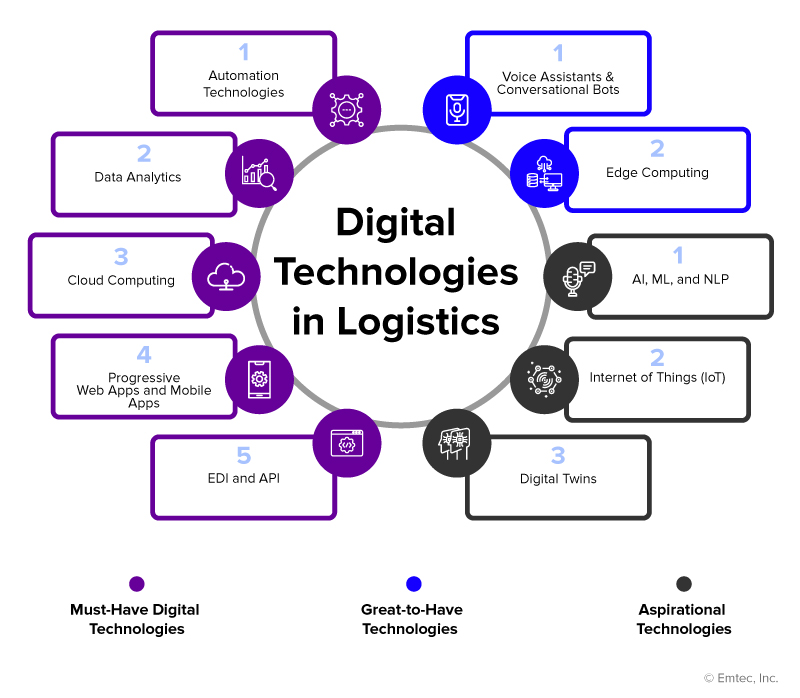In this blog, we bring you the latest developments in logistics tech. Read on to learn about the latest technologies helping companies achieve their business goals while boosting their bottom line.

Logistics tech is quickly evolving from advanced tracking systems to cutting-edge delivery solutions. But it’s not just about speed and efficiency anymore! In this blog, we dive into ten of the latest technologies that can transform logistics operations and help business operations run smoothly.
The size of the Global Digital Transformation market in logistics was valued at USD 15.93 billion in 2022. Furthermore, the market is expected to expand at a CAGR of 14.21% to reach USD 31.03 billion by 2027. – PR News Wire
Must-Have Digital Technologies in Logistics
This list includes the foundational tools required for efficient logistics operations.
- Automation Technologies
Process mining and Robotic Process Automation (RPA) are two distinct but complementary automation technologies that when used together, can significantly benefit 3PLs (Third-Party Logistics providers).
Process mining is a data-driven approach that analyzes event logs from various information systems to gain insights into business processes. It aims to discover, monitor, and improve fundamental processes by extracting knowledge from data.
RPA enables the automation of mundane, repetitive tasks, improving operational efficiency, accuracy, and productivity. RPA can be applied to many processes in many logistics verticals, including carrier onboarding. By automating key tasks and processes, RPA streamlines the carrier onboarding process, reducing errors, and enhancing operational efficiency.
Additionally, RPA can facilitate seamless communication between carriers and logistics providers, ensuring a timely exchange of information and enhancing collaboration. By leveraging RPA, logistics companies can significantly reduce onboarding time, improve data accuracy, and optimize resource allocation.
Learn more about how RPA can revolutionize carrier onboarding in the logistics industry.
-
Data Analytics
By leveraging data analytics, 3PL companies can improve operational efficiency, optimize supply chain networks, reduce costs, and enhance customer service. Data analytics enables companies to identify patterns and trends in their data, which can help them make better decisions, mitigate risks, and identify growth opportunities.
By analyzing customer data and understanding customer preferences, behaviors, and expectations, data analytics can help improve customer engagement. Logistics companies can utilize this information to personalize services and provide tailored solutions for exceptional customer experiences.
Moreover, analytics-driven sentiment analysis can monitor customer feedback and sentiment, allowing companies to address issues promptly and proactively.
-
Cloud Computing
Cloud computing provides 3PL companies with the flexibility, scalability, and cost-effectiveness to compete in a fast-paced industry. With cloud computing, 3PL companies can access their data and applications from anywhere in the world, reducing their reliance on physical infrastructure.
Cloud computing is a transformative solution which addresses challenges stemming from outdated technology and processes that lead to inefficiencies and lack of real-time visibility. Logistics companies can modernize their IT infrastructure by migrating to the cloud, replacing legacy systems with scalable and flexible cloud-based platforms. This allows for seamless integration of data and applications, facilitating real-time visibility across the supply chain.
-
Progressive Web Apps and Mobile Apps
Progressive Web Apps (PWAs) and mobile apps are application development approaches that can benefit 3PLs. Here’s how they are connected and can help 3PLs when used together:
PWAs are web applications accessed through a web browser, while mobile apps are developed explicitly for mobile devices using native programming languages (e.g., Swift for iOS, Java/Kotlin for Android). However, PWAs can also be installed on mobile devices and accessed from the home screen, like mobile apps. Both have multi-platform or device capabilities. By developing a PWA, 3PLs can provide a consistent user experience across mobile and desktop devices.
By combining PWAs and mobile apps, 3PLs can offer customers a comprehensive and flexible solution. A PWA can be built and utilized to ensure cross-platform compatibility and accessibility while also considering the development of a native mobile app to leverage specific features and reach users who prefer using dedicated applications.
Similarly, healthcare organizations face several of the same challenges that hinder patient experience. Some of the challenges include:
- Inefficient communication channels
- Limited access to information
- Difficulties in managing appointments, data records, and more.
In these scenarios, mobile-based platforms can play a significant role in resolving these challenges and improving customer experience.
Gain a deeper understanding of how these types of digital solutions can enhance customer experience.
-
Electronic Data Interchange (EDI) and Application Programming Interface (API)
Electronic Data Interchange (EDI) and Application Programming Interface (API) are technologies that facilitate the exchange of information and data between systems. They can be connected to enhance logistics operations.
Many 3PL companies use EDI to exchange business documents digitally in an efficient and standardized format. Instead of relying on postal mail, faxes, or emails, the technology connects directly to business systems, such as e-commerce solutions or Enterprise Resource Planning (ERP) systems.
API is a set of protocols, routines, and tools for building software applications. API defines how software components should interact with each other, enabling different applications and systems to communicate and exchange data.
Both technologies can be used to integrate various logistics software. For example, they can be used to integrate dynamic freight pricing into a Transportation Management System (TMS).
By incorporating dynamic freight pricing into a Transportation Management System (TMS), organizations can respond swiftly to market fluctuations and optimize their transportation costs.
A TMS, integrated with dynamic freight pricing functionality, empowers logistics providers to make more informed decisions, optimize route planning, and secure favorable pricing agreements with carriers. The ability to adapt pricing dynamically enhances transparency, facilitates efficient load optimization, and fosters better collaboration between shippers and carriers.
As we transition from ‘must-have’ technologies to ‘great-to-have’ technologies, we must recognize the interplay between these two categories. While ‘must-have’ technologies comprise the essential tools required for logistics operations, ‘great-to-have’ technologies offer additional advanced capabilities which can further enhance operational efficiency and decision-making.
The combination of both types of technologies ensures that logistics companies are equipped with a comprehensive suite of tools to navigate the challenges of the modern logistics landscape and deliver superior services to their customers.
Great-to-Have Technologies in Logistics
-
Voice Assistants & Conversational Bots
Voice assistants and conversational bots have proven to be an asset for 3PLs. With these tools integrated into backend systems, they provide self-service capabilities and additional back-office efficiencies by enabling customers to easily track shipments, request quotes, and get answers to frequently asked questions.
Organizations constantly seek innovative solutions to streamline their workflows and improve productivity in the rapidly evolving world of communication and collaboration. Prazna, a soon-to-be-launched conversational bot, aims to meet these demands by offering a secured and unified conversational interface that seamlessly integrates into existing systems and third-party services.
Prazna can be integrated into the organization’s internal systems & third-party services to provide a secure and unified conversational interface. The bot can be easily integrated with collaboration channels like MS Team, Slack, and web applications, providing an omnichannel digital experience.
Stay tuned to learn more about the transformative potential of Prazna in revolutionizing conversational interfaces!
The digitization and automation of processes in the logistics industry will reduce logistics and transportation costs by 47% by 2030. – PR News Wire
-
Edge Computing
Edge Computing is a distributed computing paradigm that processes data locally on devices or gateways instead of sending it to centralize servers or the cloud. Using edge computing technology, 3PLs can get finer tracking, analyze data in real time, and make decisions locally, reducing latency and improving response times. This is particularly beneficial in logistics operations, where quick decision-making is critical to ensure timely delivery and customer satisfaction.
Edge Computing also enables 3PLs to operate in remote or low-bandwidth areas, where connectivity to centralized servers or the cloud may be limited. Moreover, edge computing allows edge analytics, where data is processed and filtered at the edge, reducing the volume of data transmitted to the cloud and optimizing bandwidth usage. This results in faster processing, reduced data transmission costs, and improved scalability.
For logistics operations, the transformative impact of edge computing cannot be overstated. Discover how edge computing has unlocked new levels of operational efficiency in the logistics industry
Now that we have recognized the value of ‘great-to-have’ technologies in enhancing logistics operations, it’s time to raise the bar and explore the technologies that can revolutionize the future of logistics – a class of innovations known as aspirational technologies.
Aspirational Technologies in Logistics
-
AI, ML, and NLP
By leveraging the synergies of AI, ML, and NLP, 3PL companies can optimize their operations, improve customer service, enhance decision-making, and drive efficiency and competitiveness.
AI and ML algorithms can predict demand, optimize routes, reduce transportation costs, and improve inventory management, providing data-driven decision-making capabilities for 3PL providers.
Generative AI is a promising technology that has the capability to solve challenges like unpredictable demand patterns, communication barriers, and the need for real-time decision-making.
With its advanced algorithms and machine learning capabilities, Generative AI, has the potential to address these challenges by automating processes, providing real-time insights, and enabling real-time data analysis for informed decision-making.
Learn more about the role of Generative AI in the field of logistics.
-
Internet of Things (IoT)
IoT is another tool that can enable 3PLs to stay competitive. IoT technology can provide real-time tracking and visibility of shipments, enabling 3PLs to respond proactively to any issues that may arise, thereby improving customer service and increasing higher client satisfaction.
Additionally, predictive analytics derived from IoT data can be used to identify patterns and trends, allowing 3PLs to make more informed decisions and optimize the supply chain for cost savings and enhance operational efficiency.
For example, in transporting high-value goods such as jewelry or electronics, IoT sensors can be attached to the shipment to monitor the real-time location, temperature, and humidity levels. If the load deviates from its planned route or the temperature or humidity levels exceed predetermined thresholds, an alert is triggered, allowing the 3PL to take immediate action to prevent loss or damage to the goods.
-
Digital Twins
Digital Twin technology has become an essential tool for 3PL service providers to optimize their operations and improve supply chain efficiency. A digital twin is a virtual replica of a physical system or process that can simulate and analyze various scenarios in real-time. By creating a replica of the supply chain, 3PLs can identify potential bottlenecks, optimize routes, and improve inventory management.
Here is a sample use case of digital twins in logistics:
Siemens has implemented a digital twin solution to optimize the transportation of wind turbine components from manufacturing facilities to project sites. The model includes data on the physical characteristics of the elements, transportation routes, and logistics processes. By simulating different scenarios and optimizing the supply chain using the replica model, Siemens has reduced transportation costs and improved delivery times. The digital twin solution also enables real-time supply chain monitoring, allowing Siemens to respond proactively to any disruptions or delays. This has improved customer satisfaction and helped Siemens to maintain its competitive edge in the renewable energy market.
Summing Up
While timely delivery and shipping accuracy will always be primary concerns for 3PLs, the growing demand for e-commerce and omnichannel fulfillment has created a need for more innovative and sophisticated technologies. These technologies will play an essential role in how 3PL providers optimize their operations and manage their fleets to achieve their growth targets.
Bridgenext – Your Digital Technology Partner
With the right technological solutions and process enhancements, 3PLs can achieve greater transparency, visibility, and control over their supply chains, enabling better service and faster delivery times.
By partnering with Bridgenext, 3PLs can leverage our extensive knowledge and experience to roadmap their ideal future state, identify the most appropriate technologies for their specific needs, develop tailored implementation strategies, and effectively manage the transition.
Furthermore, our post-implementation support enables 3PLs to stay ahead of the curve in the rapidly evolving technological landscape, enabling them to focus on their core competencies while Bridgenext handles the support of their digital solutions.
Contact Bridgenext to learn more about how we have helped 3PL firms take a proactive step towards digital transformation as their trusted digital technology partner.
References
www.dhl.com/global-en/home/insights-and-innovation/thought-leadership/trend-reports/edge-computing-supply-chain.html
new.siemens.com/in/en/company/topic-areas/digital-enterprise/process-industry.html
www.prnewswire.com/news-releases/digital-transformation-in-logistics-market-research-report—global-forecast-to-2027—cumulative-impact-of-covid-19-301709106.html
www.pwc.com/gx/en/transportation-logistics/pdf/pwc-tl-2030-volume-5.pdf



